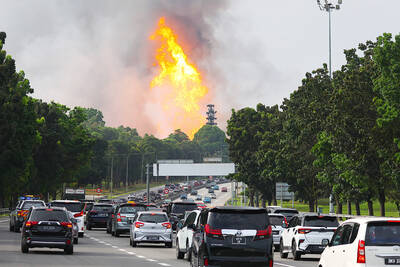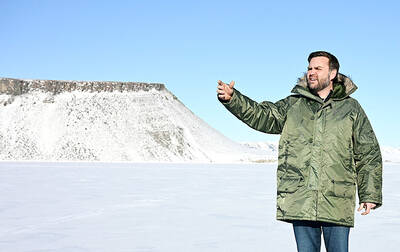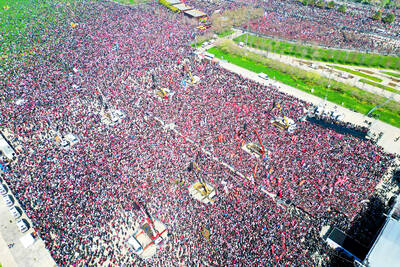Federal investigators say the government’s next generation of radiation detectors are only marginally better at detecting hidden nuclear material than monitors already at US ports, but would cost more than twice as much.
The machines are intended to prevent terrorists or criminals from smuggling into the US a nuclear bomb or its explosive components hidden in a cargo container.
The monitors now in use can detect the presence of radiation, but they cannot distinguish between threatening and nonthreatening material.
Radioactive material can be found naturally in ceramics and kitty litter, but would be of no use in making a bomb, for instance.
The US Department of Homeland Security has said the new machines it is developing can distinguish between kitty litter and dangerous radioactive material and produce fewer false alarms than the current ones.
The new machines are also better at detecting lightly shielded material.
But the machines perform at about the same level when detecting radiological and nuclear materials hidden in a lead box or casing, the most likely way a terrorist would try to sneak the materials into this country, the Government Accountability Office (GAO) said in a report to be released yesterday.
The report by Congress’ investigating agency was requested by Representative Joseph Lieberman, the Connecticut independent who is chairman of the Senate Homeland Security and Governmental Affairs Committee.
The report raises the question whether the new machines, at about US$822,000 each, are worth the cost if they’re not that much better than current ones that cost about US$308,000.
The department believes the benefits outweigh the additional cost.
But department spokeswoman Sara Kuban said on Friday the department would not comment specifically on a report that was not yet public.
She said the new machines still are being tested.
In March, Homeland Security Secretary Janet Napolitano told Lieberman’s committee that the administration was not asking for money to purchase these machines next year.
“The reason is because we were not persuaded that the technology ... the capacity of the technology that we needed, was actually there,” she said.
“Before we come to Congress and ask for more money for new technology, we needed to see something better from the science community,” Napolitano said.
For years, Congress and the GAO have been skeptical about the cost and testing of the new machines.
The new report did not criticize the department’s latest tests, but found that the results were disappointing.
The new monitors “have a limited ability to detect certain nuclear materials at anything more than light shielding levels,” the report said.
The Senate’s spending plan for the department next year calls for investing money to improve the current machines as well as hand-held radiation detectors now in use.
Because the current technology will be used for some time, “it would seem prudent to invest in this technology,” the Senate Appropriations’ homeland security subcommittee said.
The acting head of the department’s Domestic Nuclear Detection Office, Chuck Gallaway, recently told Congress that the new machines “will significantly improve our ability to correctly identify and interdict smuggled nuclear material and offer the ability to automatically sort threat materials from naturally occurring radioactive material.”

A fire caused by a burst gas pipe yesterday spread to several homes and sent a fireball soaring into the sky outside Malaysia’s largest city, injuring more than 100 people. The towering inferno near a gas station in Putra Heights outside Kuala Lumpur was visible for kilometers and lasted for several hours. It happened during a public holiday as Muslims, who are the majority in Malaysia, celebrate the second day of Eid al-Fitr. National oil company Petronas said the fire started at one of its gas pipelines at 8:10am and the affected pipeline was later isolated. Disaster management officials said shutting the

US Vice President J.D. Vance on Friday accused Denmark of not having done enough to protect Greenland, when he visited the strategically placed and resource-rich Danish territory coveted by US President Donald Trump. Vance made his comment during a trip to the Pituffik Space Base in northwestern Greenland, a visit viewed by Copenhagen and Nuuk as a provocation. “Our message to Denmark is very simple: You have not done a good job by the people of Greenland,” Vance told a news conference. “You have under-invested in the people of Greenland, and you have under-invested in the security architecture of this

Japan unveiled a plan on Thursday to evacuate around 120,000 residents and tourists from its southern islets near Taiwan within six days in the event of an “emergency”. The plan was put together as “the security situation surrounding our nation grows severe” and with an “emergency” in mind, the government’s crisis management office said. Exactly what that emergency might be was left unspecified in the plan but it envisages the evacuation of around 120,000 people in five Japanese islets close to Taiwan. China claims Taiwan as part of its territory and has stepped up military pressure in recent years, including

UNREST: The authorities in Turkey arrested 13 Turkish journalists in five days, deported a BBC correspondent and on Thursday arrested a reporter from Sweden Waving flags and chanting slogans, many hundreds of thousands of anti-government demonstrators on Saturday rallied in Istanbul, Turkey, in defence of democracy after the arrest of Istanbul Mayor Ekrem Imamoglu which sparked Turkey’s worst street unrest in more than a decade. Under a cloudless blue sky, vast crowds gathered in Maltepe on the Asian side of Turkey’s biggest city on the eve of the Eid al-Fitr celebration which started yesterday, marking the end of Ramadan. Ozgur Ozel, chairman of the main opposition Republican People’s Party (CHP), which organized the rally, said there were 2.2 million people in the crowd, but